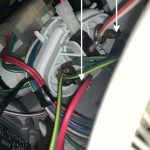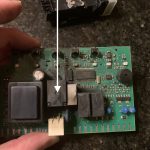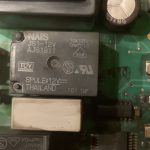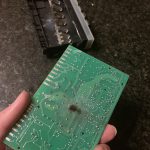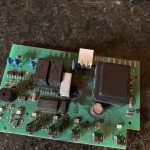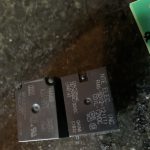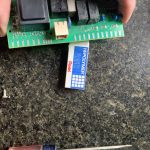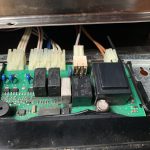We love our Bosch SHU8805 and it just turned 20 years old. Recently we noticed our plates had a white film on them, a bad odor was emitted through the sink when the discharge pump operated, and less heat/steam erupted from the dishwasher when opening the dishwasher door during or at the end of a cycle. Additionally, some nasty black sludge was hanging from the bottom inside of the door and some little black bits were caught in the drain mesh. Time to fix this!
For those needing a quick hack to stop the smell and keep limping by with what you’ve got is to clean out as much of the black matter as possible and jack up your hot water heater to the maximum temperature. We used this approach for a couple weeks until I had time to get my hands dirty.
I went through a bit more hassle than I needed to, but I wanted to make sure other components in the dishwasher were fine. If you want to skip my additional troubleshooting, skip to step 3, below.
1. It’s a good idea to make sure the heater element isn’t shot, so check it’s resistance. The heater element itself is somewhat a consumable item and Bosch wants you to replace the entire heater assembly for a couple hundred dollars. A guy in the U.K. made his own heater element replacements, but when I checked he was out of stock and frustrated with how eBay was handling his transactions. I plan to buy one from him if he ever carries more stock… Unfortunately, checking the heater element resistance requires pulling the machine out from under the countertop and using a multimeter.
I watched this video for some pointers and, fortunately, ours checked out fine! I pulled all the wires off the heater element assembly, including the thermistor, flow meter, and shut-off and measured:
2. Here’s the full throubleshooting chart for the heater element:

While assuming the heater relay was faulty, I still wanted to follow the chart to a few of its end points to make sure nothing else exhibited damage. Anyway, after obtaining the resistances above, I pushed the machine back in place under the countertop since it was late and I still wanted to loosen the door panel to observe the control board. One note, the black plastic inside the door panel is very brittle after 20 years. The black plastic covering the control board pretty much disintegrated into little pieces in my hand when I pulled it out. It was so bad I had to use a zip-tie on one side to secure it inside the dishwasher while buttons are pressed.
Skipping to the good part, I removed the control board to find the heater relay was indeed looking bad with black stains all around it on the control board:
The bottom side of the control board shows where the heater relay blew itself off:
The black stains cleaned up with cotton q-tips and 99% alcohol, paving the way for a replacement relay, although I should find out if some sort of board sealer is required to stabilize what remains – I’d probably just buy a new board, but Bosch doesn’t make them anymore! And seeing all the heat damage makes me wonder why our model dishwasher wasn’t included with CPC’s safety recall that Bosch also mentions on their website.
3. Before buying replacement relays, I soldered a jumper wire from the blown part of the board to a nearby pad on the same trace. I then initiated a 20-minute test program and the dishwasher was producing heat again, woohoo! Knowing the jumper wire is a temporary fix with the existing/damaged 10 amp heater relay, I purchased two more relays; one from MicroCenter and one from Amazon. Surprisingly, MicroCenter was the fastest option; I reserved 2 relays from MicroCenter Wednesday evening and the next morning they said I could come pick it up in-store, whereas Amazon’s part arrives Friday, I’ll keep that one as a spare or maybe return it. The new part is manufactured by NTE and rated at 12 amps, whereas the original part is rated at 10 amps. If the NTE 12 amp relay doesn’t last long I may order up a larger 16 amp relay that others on the web are reporting good success with (see video description in this YouTube video for the part number).
4. After using my trusty solder gun, the removed relay exposed an area on the control board with significant damage. I can see why models in CPC’s recall caught fire, as the condition of our control board appears to have been on a similar path with the top side of the PCB coating completely eaten away:
Here’s the replacement relay next to the removed relay:
After soldering the new relay into place, I noticed the leads on the board were starting to yellow, notice how the leads on the left of the power jack are yellowed and the leads to the right of the jack are shiny after yours truly scrubbing them with an eraser:
Finally, here’s the plugged in board going back into the dishwasher panel:
Thanks to the thousands of people who went through this and published info before me, I’m so happy to be on your shoulders and have saved our trusty Bosch from a landfill! I also used information sources, below, if you’re looking to see test methods or soldering techniques:
https://www.youtube.com/watch?v=-g43ZMtQwUI
https://www.youtube.com/watch?v=Jb8gAnMb2zQ
https://www.youtube.com/watch?v=BK9RVGy4MX0 (this guy makes the replacement heater element)
https://www.unlimitedapplianceparts.com/heater-assy-bosch-00480317-00480317/?utm_source=google&utm_medium=surfaces&utm_campaign=shopping (if I were to buy a heater element, not this time!)
https://www.youtube.com/watch?v=YjNHI1xJPmE (should I ever need to rebuild the heater element)
https://www.youtube.com/watch?v=snV2eZb8FoE (short tutorial on testing relays)
https://www.youtube.com/watch?v=2i8TUZoSdP4 (info about decalcifying Bosch dishwasher)
https://wowsoclean.com/how-to-clean-dishwasher-heating-element/ (should I ever need to decalcify the heater element, maybe running vinegar a couple times a year replaces the need for this?)
https://web.archive.org/web/20120403222555/http://gregpye.wordpress.com/ (musings from others)
http://www.farmfreshmeat.com/2014/04/bosch-dishwasher-stuck-on-1-second.html (more musings from others)

